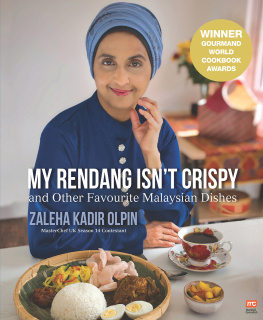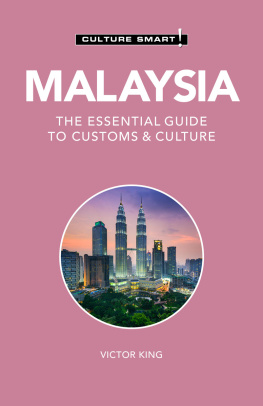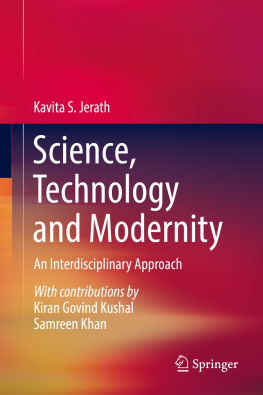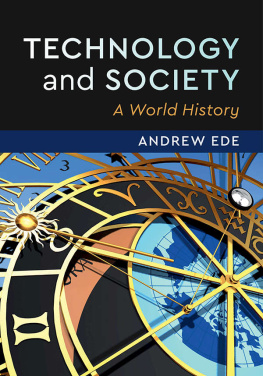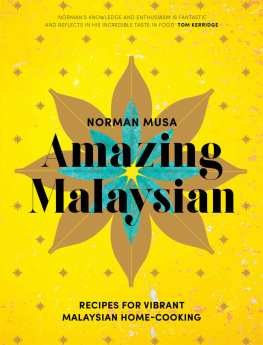MASCULINITY, POWER AND TECHNOLOGY
First published 2003 by Ashgate Publishing
Published 2016 by Routledge
2 Park Square, Milton Park, Abingdon, Oxon OX14 4RN
711 Third Avenue, New York, NY 10017, USA
Routledge is an imprint of the Taylor & Francis Group, un informa business
Copyright 2003 Ulf Mellstrm
All rights reserved. No part of this book may be reprinted or reproduced or utilised in any form or by any electronic, mechanical, or other means, now known or hereafter invented, including photocopying and recording, or in any information storage or retrieval system, without permission in writing from the publishers.
Notice:
Product or corporate names may be trademarks or registered trademarks, and are used only for identification and explanation without intent to infringe.
British Library Cataloguing in Publication Data
Mellstrm, Ulf
Masculinity, power and technology: a Malaysian ethnography
1.Men - Social conditions - Malaysia - Penang - Case
studies 2.Men - Employment - Malaysia - Penang - Case
studies 3 Labor - Malaysia - Penang - Case studies
I.Title
305.3'1'095951
Library of Congress Cataloging-in-Publication Data
Mellstrm, Ulf.
Masculinity, power and technology : a Malaysian ethnography / Ulf Mellstrm.
p. cm
Includes bibliographical references.
ISBN 0-7546-1755-6 Calk, paper)
1. Men-Malaysia-Identity. 2. Men-Malaysia-Social conditions 3.
MasculinityMalaysia. I. Title.
HQ1090.7.M4M45 2003
305.31'09595-dc21
2003041871
ISBN 9780754617556 (hbk)
Transferred to Digital Printing in 2014
Contents
List of illustrations
Acknowledgements
This book has been in progress for quite some years and I owe a great deal of gratitude to a number of people. In Penang I have made friends that will always make me return to this beautiful island. Their hospitality and generosity has been overwhelming and I have found myself a second home outside my native one.
Thank you Dr. Richard Mason for all guidance, spiritual and worldly, and for always providing me with a place to stay. Sai Ram bro! My deepest appreciation also goes to Lim Ban Ho for your kindness and true friendship.
A special thanks also goes to Robert W. Lim and Dr. Otome Klein Hutheesing. Robert has been part of this project in various ways. As part of the research team he has interviewed, proofread, and written a well-documented report which has been of invaluable help to me. Thank you Robert! Dr. Otome Klein Hutheesing has, through her intellectual and social support, been of enormous importance to this work. Thank you Otome! Through Otome I was introduced to my most important friend and informant among the foremen, Ah Teong.
I also wish to express my gratitude to a number of friends and colleagues in Penang and at USM who have helped in many different ways. I would especially like to mention: Dr. P Sundramoorthy, Dr. Jan Stark, Professor Johan Saravanamuttu, Dr Rohanna Ariffin, and Professor Wazir Jahan Karim.
In the northern part of the world where I have my family and my academic homestead, particular thanks go to my colleagues of the research group Technology, practice, identity at the interdisciplinary Department of Technology and Social Change, Linkping University. I am especially grateful to all of you who read and proofread late versions of the manuscript: Ericka Johnson, Leif Hommen, Jonas Anshelm, and Minna Salminen-Karlsson. I am also indebted to Boel Berner for providing me with the opportunity for continuing my research within the field of gender and technology. Heartfelt thanks.
I would also like to express my gratitude to Dr. Wendy Faulkner at the Science Studies Unit of the University of Edinburgh for her continuous encouragement and invaluable intellectual support. My thanks go also to Dr. Nadia Lovell at the Department of Social Anthropology, Linkping University who provided me with critical comments that helped me get further and focus my study. My friend Felisa Tibbitts in Boston, U.S. proofread two chapters at a critical stage of this work and for this I am most grateful. My friend Simon Ivarsson has, with his usual exactitude and virtuosity, edited the pages that follow. Special thanks also go to the staff at Ashgate for their patience and helpfulness, in particular Pauline Beavers.
As I wrote eight years ago with the help of Ann-Carita (Mellstrm 1995:1): my most intimate friend, lover, intellectual companion and actor, (Evaldsson 1993:VIII) Ann-Carita Evaldsson has through her passionate intellectualism structured my ideas more than I perhaps ever will realise. I am a favoured person to be able to share my life with such a talented, loving and caring person. What I said then is even more true today since our love has deepened and grown over the years. At that time Fanny was eight and Sonja was three. Today, they are sixteen and eleven but still constant sources of joy and happiness. Thanks for being there.
Last but not least I dedicate this work to the mechanics, Tan Ben Teong, Saw Guan Hock, and Tan Theik. Eight years ago I could never imagine that I would have dear friends in the working-class suburbs of Georgetown, Penang, Malaysia. Today this is true and it has enriched my life beyond my own imagination. Thanks for having shared your lives and work with me!
This work has been made possible by grants from the Swedish Research Council (FRN) and the Swedish Agency for Innovation Systems (Vinnova, earlier RALF).
Versions of Chapter Four are published in Mellstrm 2002, 2004.
Friday 14/1 -00
07.00
Waking up. Getting dressed and having breakfast. Waiting to get through to Tan because I said I should call before I go over to his house. Cant get through the first three times I tried to call but eventually the line is clear and I reach Tan.
It is around 8.00 am and I am riding my scooter from my apartment outside Georgetown down to Jelutong five minutes away to meet Tan, a car mechanic in his early forties. I do find my way to his house, since I have been here a number of times before; it is the third block closest to the busy mainroad outside the gates. The medium-cost blocks that were constructed over ten years ago (1988) are now looking a bit run down from the outside. The formerly white walls have taken the colour of grey, but to my surprise, the inside is well kept and seems to be well built. The apartments are over 800 sq ft, which is quite big in comparison to other high-rise apartments, flats and condominiums in Penang. At the time Tan bought the apartment for 66,000 RM. (Malaysian Ringgits), which should definitely be considered a good deal since prices have both doubled and tripled since the late 1980s. When I enter the apartment, Tans mother who stays with the family, his ten-year old daughter and their Indonesian maid are home. His fifteen-year older daughter is at a friends house and his wife is at work in a Bayan Lepas factory as a line leader in a multinational semiconductor company in the Free Industrial Zone (FIZ) of Penang. Her normal shifts start early (6.30 am), which means that she leaves the house before everybody else in the family.
Tan asks me to sit down while he is preparing himself for a new workday. The apartment of four rooms and a small kitchen is rather sparsely decorated with an aquarium, a leather sofa, a book-shelf with a fully equipped home-theatre hifi-set, a huge TV-screen in the middle as well as different family belongings such as family photos. I stay around for another ten minutes while Tan instructs the maid to take his mother out for a short walk as well as what food she should prepare for the mother and the children. It is their last week of school holidays and according to Tan they are not very happy about starting school again.



